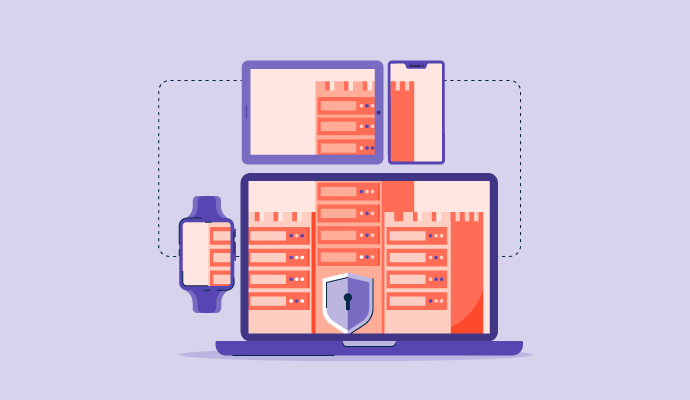Today, network security is more critical than ever.
The modern threat landscape is perilous. Sophisticated malware and targeted attacks pose a significant risk to businesses. They can infiltrate networks undetected, steal sensitive data, disrupt operations, or hold systems hostage through ransomware. Such cyber attacks have far-reaching implications, impacting a business's bottom line, reputation, and overall stability.
Security teams and business leaders constantly struggle to balance robust security with a frictionless user experience and ensure uninterrupted business operations.
This has brought to the forefront the need for strategic investment in network security to ensure that the network and all that come with it are safe from cyber-attacks. But what is network security and how do businesses effectively implement it? This article answers your question.
What is network security?
Network security is a set of policies, tools, and security practices that protect a computer network and its data from unauthorized access, modification, disruption, or abuse.
With a set of hardware and software technologies, it safeguards the network integrity and usability. There are many paths you can take to thwart attackers. Network security solutions like firewalls, intrusion detection systems, anti-virus software, and access control solutions form the foundation of this multi-layered defense, while network security policy management (NSPM) solutions streamline security policy creation and enforcement.
If you are unsure how to secure your network, keep reading. We'll explore how network security works, different network security technologies and related software solutions and find the best fit for your needs.
How does network security work
Network security safeguards your network by implementing various policies, controls, and tools at all seven layers of the network to address specific risks and weaknesses. This layered approach ensures that only authorized users gain access to network resources and protects your data from cyber threats.
Following are the core components of network security system that you should know about for a robust network security posture:
- Authentication: Verifies user identity using methods like passwords, security tokens, and biometrics to ensure only authorized users can access the network.
- Access control: Utilizes firewalls and access control policies to manage and restrict user access to network resources.
- Threat detection and prevention: Implements tools such as anti-virus software, intrusion detection systems (IDS), and intrusion prevention systems (IPS) to identify and mitigate malware and other cyber threats.
- Encryption: Secures data in transit by encrypting communications between network hosts to protect against eavesdropping and interception.
- Monitoring and analysis: Continuously monitors network traffic for anomalies and potential threats, often using advanced analytics and machine learning.
- Incident response: Develops and deploys plans to respond to and recover from security incidents, ensuring minimal impact and quick restoration of services.
There are three essential phases you'll go through while implementing network security:
- Protection: Make sure that your network systems are configured correctly.
- Detection: Identifying when any configurations have changed or when network traffic indicates a problem.
- Reaction: When a problem is identified, respond quickly so your network can respond to its safe state as soon as possible.
To achieve this, multiple network security technologies are deployed across different layers of the network.
¿Quieres aprender más sobre Software de Seguridad de Red? Explora los productos de Seguridad de la Red.
Why is network security important
Network security is vital because it goes beyond just protecting sensitive data. It ensures the uninterrupted functioning of daily operations. While protecting against cyber threats like data breaches and unauthorized access is critical, strong network security also shields businesses from disruptions caused by cyberattacks.
For example, attacks like DDoS (Distributed Denial of Service) can bring systems to a halt, resulting in significant financial losses and reputational damage. A well-secured network minimizes these risks, keeping systems up and running smoothly. In this way, network security serves as a backbone for business continuity.
By implementing measures like firewalls, encryption, and intrusion detection systems, organizations not only protect their data but also secure the seamless operation of their processes.
This dual benefit of safeguarding both sensitive information and system functionality makes network security a crucial pillar for any business or individual relying on digital platforms.
However, it’s easy to get tangled up in the concepts of network security and cybersecurity. While these two fields are closely related, they focus on distinct aspects of securing digital environments. Let’s break down the differences.
Cyber security vs. network security
The difference between cyber security and network security comes mainly from heir scopes and priorities.
- Cyber security encompasses the protection of all data, systems, and networks from cyber threats and attacks. It is a broad field that includes various sub-disciplines such as information security, network security, application security, and operational security.
- Network security specifically focuses on protecting the integrity, confidentiality, and accessibility of data as it is transmitted across or stored in a network. It includes measures to prevent unauthorized access, misuse, or theft of network resources.
Now, let's take a look at the tools and technologies that help with network security.
14 types of network security tools and technologies
Achieving robust network security requires a layered approach as mentioned earlier. Relying on just one solution can leave vulnerabilities, so it's essential to combine multiple tools and technologies for comprehensive protection.
1. Firewalls
Firewalls are the barrier between your trusted internal network and the untrusted outside network, such as the Internet. Using a specific set of rules either allows or blocks specific types of traffic from entering your network, helping with access control. A firewall can be hardware, software, or both.
Based on your needs, you can employ different firewall technologies like:
2. Access control
Not everyone needs access to your network. To keep out potential hackers, the access control center can note each user and each device and determine which ones are allowed in. This is often referred to as network access control (NAC) and is accomplished using NAC software.
In addition to NAC, identity and access management (IAM) solutions help you with role-based access management. These tools employ different verification technologies like two-factor authentication to allow only authorized users and devices access your network.
Other software solutions for access control
Integrating your NAC and IAM solutions with the following security solutions fortifies your network security.
3. Anti-malware software
Malware, which stands for “malicious software”, consists of everything from worms, viruses, spyware, Trojans, and ransomware. Sometimes, your network will be infected by malware, and the bug will lay dormant for weeks, only to reveal itself at the worst possible time.
Antivirus software designed to detect malware not only scans for these viruses and blocks them from entering your network but also keeps track of your files for any anomalies and fixes damage that may occur.
Beyond the traditional antivirus solution, more advanced tools like endpoint detection and response (EDR) systems offer comprehensive protection. These tools go beyond signature-based detection, continuously monitoring endpoint activity for suspicious behavior.
4. Application security
Any and all software your company uses, whether built by your IT department or purchased from another vendor, must be protected. Any software program or application could contain holes, allowing hackers to infiltrate the network. Application security patrols all of your company's software and closes any holes.
Major application security technologies
Following are different application security tools you must consider to secure your network based on your needs:
5. Data loss prevention
Sometimes the weakest links within a network aren’t the holes that can appear but the people who manage and work within the network. It's imperative that you know how to map a network drive. Human beings can oftentimes be the ones that do the most damage to your network security efforts, resulting in data breaches.
When data loss prevention technology is implemented and processed to ensure employees don’t send sensitive data outside of the network, you can be sure that uploading, forwarding, or printing critical company data doesn’t occur.
Tip: Use backup software and as a complement to DLP software for full protection against data loss.
6. Email security
One of the most common ways attackers can hack a network is through email, especially phishing. This social engineering tactic makes it easy for hackers to gain access to your personal information, as they deceive their recipients and send them to sites that contain malware.
When you use email security software, you can better protect your network as it blocks incoming attacks and has control over outbound messages.
Tip: Make sure you have enforced all email authentication protocols if you use emails extensively for marketing and sales.
7. Mobile device security
While we often think of our network as just our actual computer, cybercriminals can easily access our network by targeting our mobile devices and the applications we download.
And given the rise of remote work and bring-your-own-device policies, you must control which mobile devices can access your network while configuring their connections to keep your network traffic private. Mobile device management (MDM) systems and mobile data security software aid you to do this.
9. Virtual private network (VPN)
Remote access business VPN software encrypt connections to your corporate network over the internet and establish secure network connection. Many security suites offer VPN as part of their package.
10. Network segmentation
Network segmentation divides your network into smaller segments to limit the spread of potential threats and improve security control. Software-defined perimeter software helps with network segmentation.
11. Intrusion detection and prevention
Intrusion detection and prevention system (IDPS) is essential to monitor your network traffic for suspicious activities and potential threats.
An intrusion detection system generates alerts when anomalies are detected, and the prevention system takes action to block or mitigate detected threats. Some NGFWs come with a built-in IDPS system.
Other tools to monitor and analyze network infrastrucutre
12. Security information and event management (SIEM)
Security information and event management software, or SIEM, is vital to network security. These products come in various forms, but they all pull together the data needed by the security staff from the network infrastructure to identify and respond to threats promptly.
13. Zero trust networking security software
Zero trust networking (ZTN) security solution is an emerging network security tool that is based on the principle of "never trust, always verify." It assumes that threats can exist both inside and outside your network and, therefore, mandates strict verification for any user or device trying to access resources.
14. Network security policy management (NSPM) solution
Network security policy management is crucial for maintaining a secure and compliant network environment. It helps organizations manage and enforce network security policies effectively, ensuring consistent protection across the network. You can use an NSPM solution to do this easily.
Other related network security services and software t
Apart from the ones mentioned above, there's an arsenal of security tools that are not strictly related to network security but improve your network security posture. Some of them are:
If you are feeling overwhelmed by these different types of technologies and struggling to find the best network security services for your needs, chat with Monty, our AI software assistant.

Benefits of network security
Every business and organization, regardless of its size and industry, requires some level of network security to shield itself from cyber threats. Here's how robust network security benefits your organization:
- Protects sensitive data from unauthorized access, theft, or corruption.
- Prevents slowdowns and interruptions by mitigating attacks like denial of service.
- Helps organizations comply with industry standards and legal requirements for data protection.
- Reduces potential financial loss from data breaches, fines, and recovery efforts.
- Builds trust among customers and stakeholders by ensuring data privacy and security.
- Defends against malware, viruses, ransomware, and other cyber threats.
- Ensures business continuity during and after security incidents with specific policies and practices.
- Identifies and mitigates vulnerabilities in the network to reduce overall risk.
- Maintains data accuracy and consistency over its entire lifecycle.
Challenges of network security implementation
Organizations encounter a number of problems while implementing network security technologies to protect their digital assets from cyberattacks. These range from technological complexity to human error and cybercriminals' ever-evolving tactics.
- Constantly evolving threat landscape: The rapid evolution of cyber threats makes it difficult to keep up with new attacker tactics.
- Cloud security challenges: Using the cloud infrastructure introduces new security complexities to take care of.
- Integration challenges: Since network security involves implementing several technologies at different network layers, integrating different security solutions for comprehensive protection will be difficult.
- Cost: Significant investments are required for hardware, software, and personnel.
- Performance impact: Security solutions can sometimes slow down network performance, impacting business operations.
Your network, your rules
When it comes to securing your network, it’s not just a priority – it’s a necessity. With a range of tools and strategies at your disposal, the key is to implement the right measures that will prevent hackers from gaining access to your system. By taking control of your network security, you can effectively minimize risks and ensure peace of mind.
Looking to learn more? Explore what network access control is and how it strengthens network security.

Mara Calvello
Mara Calvello is a Content and Communications Manager at G2. She received her Bachelor of Arts degree from Elmhurst College (now Elmhurst University). Mara writes customer marketing content, while also focusing on social media and communications for G2. She previously wrote content to support our G2 Tea newsletter, as well as categories on artificial intelligence, natural language understanding (NLU), AI code generation, synthetic data, and more. In her spare time, she's out exploring with her rescue dog Zeke or enjoying a good book.

